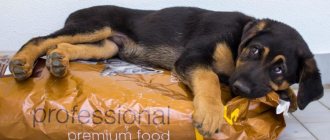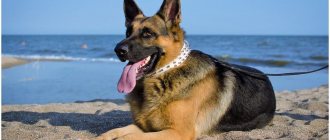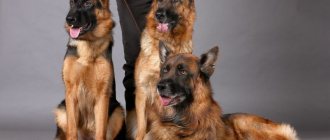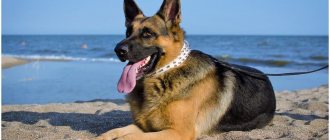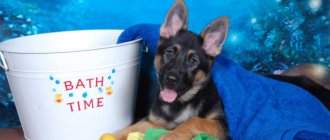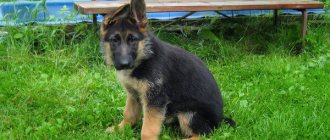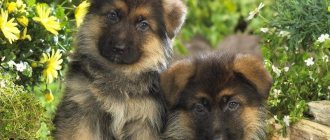German Shepherds are one of the smartest and most loyal dogs in the world, delighting their owners with energy and endless love of life throughout their lives.
However, before purchasing a puppy, you should find out about the health characteristics of representatives of this breed.
In particular, their hind legs often fail.
And in this situation, you need to know how to help your pet.
What problems can your pet encounter?
Chronic musculoskeletal problems
Chronic diseases of the musculoskeletal system include:
- dysplasia of the hip or elbow joint - most often a genetic pathology associated with abnormal development of the joint;
- knee dysplasia is a congenital joint disease in which malformations lead to damage to bone and cartilage and, as a consequence, osteoarthritis;
- panosteitis (pano) is a pathology called “wandering lameness” and is characteristic of puppies 5-12 months old.
It is also possible to develop arthrosis and arthritis.
Amputation of the first dewclaws in puppies over 21 days of age
The dewclaws in dogs are the fifth digits on the hind limbs, the need for which has disappeared during the evolutionary process. Most show dogs have them removed at an early age because they impede movement, but in a number of breeds, such as the Pyrenean Mountain Dog and the Briard, they are a breed feature, and they must have two dewclaws on each metatarsus.
Figure 1 – Dewclaws on a dog.
Poodle breeders remove not only the dewclaws on the hind legs, but also the fifth toes on the front legs, which are left untouched in most dog breeds.
Why do dogs have dewclaws?
The mode of inheritance of extra digits (polydactyly) on the forelimbs is unknown. Some authors believe that dewclaws on the hind limbs are dominant over their absence. This is typical for German Shepherds, who have practically no dewclaws, as well as for marriages. The situation is different with collies and border collies. Regarding the latter breed, parents who do not have dewclaws may well produce offspring that will have them. This suggests that dewclaws are a recessive trait in this breed. Scientific studies have revealed that in dogs carrying one dewclaw gene, its phenotypic manifestation was only in 47% of them, and not in all, as would be expected. As for double dewclaws (Fig. 2), geneticists believe that this trait is recessive in relation to single dewclaws. Single and double dewclaws are autosomal dominant traits that are independent of each other. Some dog families may carry both of these genes.
Figure 2 - Double dewclaws.
During the neonatal period, dewclaw amputation and tail docking are practiced in dogs of many breeds. The best time to perform these operations is the 1st week of life.
During this period, puppies are insensitive to pain, and therefore surgery can be done either with or without local anesthesia.
Why is it necessary to remove dewclaws?
Dewclaws are usually removed from the hind legs. Due to the absence of flexors and extensors, they are functionally inactive. The claws on these fingers do not wear off, break easily, or tend to grow into the skin of the limb. For an adult dog, dewclaws are a big hindrance when walking and running. They are injured when moving on loose soil, snow, etc. Therefore, as well as for cosmetic purposes, it is recommended that puppies have their dewclaws surgically removed no later than 2-3 months of age. On the front legs, the dewclaws are not removed, since they are equipped with flexors and extensors and the dog can control them.
In which breeds is it recommended to remove dewclaws?
Dewclaws are removed from the following dog breeds:
- Alaskan Malamute
- Belgian raspberry
- Belgian Cattle Dog
- Belgian Tervuren
- bernese mountain dog
- boxer
- weimaraner
- East European and German Shepherd
- Dalmatian
- Dandie Dinmont Terrier
- cardigan welsh terrier
- Komondor
- Carrie Blue Terrier
- lakeland terrier
- Moscow watchdog
- Norwegian elk dog (elkhound)
- papillon
- Saint Bernard
- Siberian husky
- Silky Terrier
- Sheltie
- Chesapeake Bay Retriever
In which dog breeds is dewclaw removal prohibited?
According to the breed standard, amputation of dewclaws is prohibited in:
- Briard
- Pyrenean mountain dog
Dogs of these breeds must have two dewclaws on each hind limb.
How is the operation performed?
The operation is carried out as follows: prepare the surgical field - cut the hair, wipe the skin with antiseptics; infiltration anesthesia is used. If there is a joint, then anesthesia is injected around it and into the glenoid cavity. To remove a finger, you must have large hemostatic tweezers, pointed scissors or a scalpel.
After the onset of pain relief, after 3-5 minutes, the clamp is applied to the finger behind the joint. If there is no joint, then this is done as close to the metatarsal bones as possible. Then the finger is cut off with scissors or a scalpel. The finger that has the joint is removed by inserting scissors or a scalpel into the joint space. After the bleeding has stopped (in puppies it is insignificant), an interrupted suture is placed on the edges of the wound and the postoperative wound is treated. As a rule, healing occurs by primary intention. The sutures are removed on the 7th day. In adult dogs, the sutures must be protected from licking (protective collar) and treated daily with antiseptic agents; the sutures are removed after 10-14 days.
ATTENTION!!!
The younger the puppy, the less discomfort this procedure gives him.
Reasons for refusal
Impaired performance of the musculoskeletal system of German Shepherds can be caused by various diseases.
Dysplasia
A chronic pathology in which destruction of joints, ruptures of bone tissue and cartilage occurs.
If we are talking about an acquired disease, then it develops as a result of improper diet , obesity , deficiency or excess of vitamins and minerals, as well as due to serious physical activity in the puppy.
In cases where the disease is hereditary, animals have congenital abnormalities in the structure of the joints.
NOTE!
Symptoms appear only when the puppy reaches six months of age.
A sign of dysplasia is a hunchback instead of a smooth line.
Spinal diseases
As a result of bruises, as well as with discopathy, spondylosis, spondyloarthrosis and osteochondrosis, the fibrous rings are damaged, swelling and compression of the spinal cord and peripheral nerves are observed.
All this leads to the death of cells of the nervous system, which manifests itself in weakness of the limbs: from lameness to complete failure..
In some cases, spinal injuries can cause complete paralysis of the hind legs.
Oncology
Malignant or benign neoplasms on the brain or spinal cord, paws or spine can also cause malfunctions of the musculoskeletal system - tumors put pressure on the tissues and structure of the central nervous system.
There is a possibility of finding small swellings on the paws of older German Shepherds, and the dog may be limping and dragging its limbs.
If the tumors are localized in the spinal cord or brain, the German Shepherd experiences severe pain and paresis or complete paralysis of the limbs is noted.
Injuries
Injuries to the limbs, head, or spine sustained by a German Shepherd during play, fighting, walking, or an accident are another possible cause of hind leg failure.
In addition, any awkward movement, jump or fall of the dog can lead to a fracture, sprain, ruptured tendon or pinched nerve..
Expert opinion
Kozhevin Semyon Kirillovich
Expert dog handler.
German Shepherds are prone to developing diseases associated with the musculoskeletal system, therefore, first of all, they need a set of preventive measures to avoid limb failure. However, this can often be the result of a hereditary disease, when it is impossible to avoid the consequences. At the first signs of limb failure, you should immediately contact a veterinarian - only a specialist can carry out the necessary diagnostics and prescribe treatment. Remember - self-treatment will most likely be incorrect and can lead to death.
Signs of limb damage
If a dog has any disease associated with the hind limbs, it will manifest itself noticeably. Therefore, it is quite easy to understand that your pet is sick. You just need to take a close look at his behavior and activity.
Signs of serious illness may include:
- Noticeable weakness of the limbs;
- It is difficult for your pet to walk, he is limping on his hind leg;
- There are no visible injuries on the legs, but the pet has difficulty getting up from a lying or sitting position, or there are swollen places on the legs;
- Often the animal drags its paws or they shake, that is, convulsions occur;
- If the pain is severe, when walking the shepherd tries to show that it is in pain, whines, and prefers to move less;
- The dog walks on straight legs without bending them.
These ailments, characterized as failure of the hind legs of a shepherd dog, can be either genetic, hereditary or acquired by the pet during life.
If these symptoms make themselves felt, you should not delay treatment. It can only be carried out on the recommendations of a veterinarian. Practicing self-medicine is not only not worth it, but strictly prohibited. Otherwise, it can lead to even worse consequences.
Symptoms of pathology
The fact that a German Shepherd's limbs are failing can be judged by the following symptoms::
- the dog squats on its paws, limps, while moving, the limbs remain straight and do not bend at the joints;
- the pet whines and squeals during movement due to severe pain;
- rapid breathing and convulsions are observed;
- swelling forms on the paws in the area of the joints;
- the animal prefers to lead a recumbent lifestyle or, on the contrary, behaves restlessly;
- in some cases, the German Shepherd cannot stand on its paws and drags them behind itself when moving;
- It is possible that aggression may occur when the owner or doctor tries to examine the hind legs or simply touch the back.
The earlier the pathology is diagnosed, the higher the chances of a positive outcome of therapy, so it is important for the owner to know about the symptoms of the disease.
Perirectal fistula of the German Shepherd
Perirectal fistula is a chronic, progressive condition that affects the area around a dog's anus. German Shepherds are particularly susceptible to this disease (84% of German Shepherds are diagnosed). Perirectal fistulas usually affect middle-aged male German Shepherds (5-8 years), but also younger dogs (1 year of age) and older dogs (14 years of age). The exact cause of the disease is unclear. Inflammation of the sweat and sebaceous glands in and around the anus is thought to cause infection. As a result, abscesses form, open and begin to leak. German Shepherds with low-set tails that are held close to the body are more prone to developing these fistulas because there is no air circulation under the tail, creating a perfect breeding ground for bacteria. Symptoms of this condition include: constant biting or licking of the perianal area, rolling on the floor. Other possible symptoms include constipation, diarrhea, or bloody diarrhea. There are ulcers and bleeding around the anus, as well as a discharge with an odor.
Harbingers of paw failure
The first signs of limb failure can vary depending on the cause.
So, with dysplasia, you need to pay attention to:
- lameness;
- instability of the paws and, as a result, an unsteady gait;
- fatigue;
- heavy lifting from a lying position;
- audible cracking of joints.
In case of injury, the damaged area swells, hematomas form, the dog experiences pain and whines, squeezing its paw.
CAREFULLY!
With pathologies of the spine, the dog shuffles and limps, and over time the limbs fail completely.
Under no circumstances should changes in the dog’s behavior or mood be ignored - even seemingly insignificant moments may turn out to be the first signs of a serious pathology.
Symptoms may appear gradually, replacing or complementing each other, or appear suddenly.
Important points
When purchasing a service dog for an apartment, owners should not forget about their neighbors and residents of the neighborhood. After all, a large dog causes not only fear but also dissatisfaction in many people, so it is important to remember the mandatory details of walking these domestic “giants”; it is radically different from walking Orkshire terriers. Firstly, the dog should have a wide two-layer leather collar approximately 40-60 cm long and 3-4 cm wide. The collar should already have a solid half-ring for the carabiner and a strong buckle sewn in. When choosing a collar, keep in mind that the tensile strength should be 5 times the dog’s own weight. In addition, for walking you must have a strong leather leash at least one and a half meters long and, of course, a muzzle, mesh, made of leather or rods. But do not forget that while wearing a muzzle, the dog must have good air access, as well as the ability to open its mouth slightly (when it is hot). Walking your dog near a residential area should only be on a leash and wearing a muzzle. Remember that a service dog is designed to protect and protect, so its instinct to attack or aggression is heightened. Even with the most well-mannered and kind dog, never lose sight of these factors.
And it is also worth noting that keeping a service dog in an apartment requires strict adherence to a daily routine. The dog should have regular time to sleep, eat, walk, play, train and rest. Only if a clear life schedule is observed, both the dog and the owners will be able to feel comfortable even in a small apartment.
Why are people rejected at puppy age?
Weak joints and muscles are a feature of the physiology of German Shepherd puppies.
Often between the ages of 3 months and 5 months they may notice :
- lameness;
- falling on your hind legs or pulling them up when walking;
- X-shaped paw set;
- squatting on limbs.
If any of these manifestations of weakness of the limbs and muscles occur, it is necessary to take your pet to a veterinarian..
Based on the results of the examination and tests, the doctor will prescribe medications and make recommendations regarding a diet and training that will help build and shape the muscle corset and strengthen the musculoskeletal system.
If limb failure is the result of joint or central nervous system pathology, the success of the therapy depends on how quickly the correct diagnosis is made.
Why did the little puppy's hind legs fail?
Even at a young age, a German's paws can fail. Problems arise during the period of growth and formation of the musculoskeletal system. People begin to worry when signs appear:
- a crossed position of the hind limbs appears, the front ones - in the form of the letter X;
- lameness;
- being in a half-squat;
- frequent unexplained falls;
- reflex stretching of the hind limbs.
The puppy begins to get sick due to a lack of vitamins, phosphorus and calcium in the body. The paws of a young German Shepherd may fail due to a lack of muscle mass, diseases of the nervous system, infection or injury to the joints and ligaments. To correct the situation, the puppy needs to be shown to a veterinarian as soon as possible.
Diagnostic methods
Making a diagnosis includes a set of the following measures::
- general examination;
- taking anamnesis;
- laboratory tests of blood, urine;
- Ultrasound and X-ray;
- MRI and CT using contrast agent;
- checking reflexes and paw sensitivity.
Depending on the results of the examination, a diagnosis is made and drug treatment is prescribed or a decision is made on the need for surgical intervention.
What is arthritis?
This concept combines a group of inflammatory diseases that cause pathological changes in the joints in dogs. In a normal situation, pain from constant bone friction is neutralized by the synovial fluid covering the surface of the hyaline cartilage.
But as a result of pathology, cartilage tissue loses its protective function, and any movements cause acute pain. Along with discomfort, the likelihood of injury also increases.
A pet with sore joints loses its usual activity and gradually gains weight, causing associated complications. One of the most dangerous is the penetration of infection. Due to deformation and gradual narrowing of the joint space, the only way to save the animal from intoxication is truncation of the affected paw.
How to avoid problems for a puppy
To strengthen your puppy’s muscles and ligaments, you should follow these recommendations::
- before the dog turns 1.5 years old, it is necessary to give it cottage cheese and other fermented milk products, as well as vitamins and nutritional supplements containing calcium, but strictly in the dosage recommended by the veterinarian;
- supplement the puppy’s diet with preparations containing glucosamine and chondroitin;
- observe the feeding regime and the principles of a balanced diet;
- provide your pet with moderate physical activity that promotes the formation and strengthening of the muscles of the limbs;
- eliminate the possibility of overfeeding the dog, leading to obesity and increasing the load on weak paw muscles.
It is also important to ensure that the place where the puppy plays has a smooth, non-slip surface and is free from drafts..
Keeping a service dog in an apartment
The group of service dogs includes almost all types of shepherds, Groenendallies, Newfoundlands, St. Bernards, Mountain Dogs and many other dog breeds. Service dogs are distinguished from all other large types of dogs by their good endurance and innate watchdog qualities. They are not only excellent defenders and guards, but also very kind, obedient pets. Many people simply cannot imagine their life without these big four-legged friends, forgetting that caring for and maintaining them differs from the usual rules. Especially if you live in an apartment. In order for a service dog to be healthy and beautiful, you need to properly organize care, know the basic needs, as well as the influence of environmental factors. Let's figure out together what you need to remember when purchasing a service dog for your apartment.
Apartment maintenance
It's probably no secret that service dogs need a lot of space. And not even because almost all representatives of this group are massive and large dogs. They are simply destined by nature to have a great view around them. Therefore, a small apartment or cramped room is not the best option for keeping a service dog. If your living space cannot boast of luxury, then the main rule in caring for your dog should be a good walk. At the same time, an hour's walk around the neighborhood will not be enough. Living in an apartment, a service dog must run, jump, practice training skills, and also walk without a leash every day. And, of course, a city park is not suitable for such walks.
The best place to walk service dogs is in forests or coastal areas. The next rule is the apartment “climate”. When keeping a dog in a small room, you need to carefully monitor the cleanliness of the air, since the dog exhales approximately 23 liters of carbon dioxide per hour. During the warm season, the balcony or windows should always be open, but in winter you need to ventilate for about 10 minutes every hour. As you know, dogs have a higher body temperature than humans, so the temperature in the apartment is also an important factor in keeping the animal. In addition, service dogs have fairly thick skin with increased function of the sebaceous glands. In the apartment, the dog must be provided with a separate place, away from drafts and heating systems. The dog must not be locked in the kitchen or pantry. Due to their natural watchdog qualities, such dogs, as a rule, choose hallways or corridors as their resting place in order to control the front door. In an apartment where a large dog lives, daily wet cleaning with a disinfectant should be carried out. Therefore, in places where the animal is especially frequent, it is better to remove paths and carpets. Also monitor the humidity in the room. It should not exceed 70%. In addition to the tongue, the paws also serve as a unique mechanism of thermoregulation in dogs, so in the winter the dog needs to be provided with warm bedding, but in the summer, on the contrary, a cool place with an unmade floor.
Service dog hygiene
Keeping a service dog in an apartment must be accompanied by enhanced “personal” hygiene of the animal. But at the same time, owners must remember that it is not recommended to wash service dogs frequently, but they should brush their fur and inspect their skin every day. As a rule, it is better to do this outside, but not in walking areas. To do this, you need to purchase a special brush for cleaning hard hair, as needed, for example, for a Newfoundland or collie, a comb with metal sparse and blunt teeth, as well as a small piece of cloth for wiping. During cleaning, it is important to examine the dog’s skin, especially in hard-to-reach places (the area behind the ears, paws, elbow bends). The coat should be combed, starting from the head and smoothly moving to the tail. Sometimes long-haired dogs' fur can become matted and matted. In order not to hurt the animal, the tangles must be sorted out by hand before combing. Eyes, ears and nostrils should be wiped with a soft, slightly damp cloth. Due to the excessive production of sebaceous glands, service dogs are washed only when necessary. In the warm season, about once a month.
To do this, it is better to use a special shampoo or baby soap. Moreover, experts do not recommend applying detergent directly to the dog’s fur, but diluting the foam in a separate container. You need to bathe your animal in the evening after a walk. During the night, the undercoat will dry well, and the skin will not freeze. You can also use a special solution of equal parts water, alcohol and vinegar to clean wool. You need to moisten gauze or bandage in the solution and wrap it around a comb and comb the hair. While washing your dog often is not recommended, swimming in a pond in the summer, on the contrary, is encouraged. This hardens the body well and trains the muscles. In hot weather, long-haired dogs can be taken to a pond every day, it can even be a kind of walk. Another important point: if under normal conditions a service dog sheds twice a year, then in a warm apartment it can last constantly. Thus, the dog’s body adapts to warm living conditions. Therefore, the owners will have to comb the fur every day. You can also use a vacuum cleaner if the dog is accustomed to this kind of “procedure”. And don’t forget that an apartment dog needs enhanced care, examination and preventive procedures.
Treatment regimen
| The cause of the pathology | Treatment |
| Dysplasia | At an early stage of the disease, a diet, restriction of physical activity, taking chondroprotectors and painkillers, and a course of physiotherapy are prescribed. In severe cases of the disease, surgical intervention will be required, which will involve resection arthroplasty and triple osteotomy. |
| Oncological diseases | If, as a result of the examination, it is determined that the tumor growing in the spinal cord or brain is malignant, then medicine is powerless. One option is to euthanize the dog. Otherwise, it is possible to use painkillers and hormonal drugs to maintain the life of the pet. |
| Injuries | Treatment is prescribed based on the nature of the damage. For bruises, sprains and closed fractures, the doctor uses fixing bandages and prescribes painkillers and a course of physiotherapy; for dislocations, the joints are set; for open injuries, surgical intervention is necessary. If the integrity of the spinal cord or brain is damaged, it is impossible to cure a German Shepherd. |
| Spine pathologies | Depending on the stage of the disease the German Shepherd was diagnosed with, the pet will be prescribed anti-inflammatory, painkillers and hormonal medications, and complete rest is recommended. In some cases, surgery is required. |
Treatment of this pathology requires a lot of effort and time, and its success depends not only on the competence of the doctor and the speed of diagnosis, but also on the age of the dog, the severity of the injuries and the presence of concomitant diseases.
How to help your pet
Owners are required to immediately take their pet to a doctor. Considering the age of the dog, approach the situation responsibly so as not to run into “good” advice to euthanize the animal.
There is no need to fall into despair; there is still a chance, if not to cure the pet, then to improve the condition and quality of life of the animal. Based on the results of the examination, the doctor will prescribe injections, massage, and may require surgical intervention.
In parallel with the main treatment, the dog is prescribed a restorative massage, which can be done at home. A set of rehabilitation exercises is used to restore normal motor activity. However, it will not be possible to completely cure a dog at home without the help of doctors.
Prevention
In order to prevent limb failure, it is necessary:
- up to 1 year constantly, after that - from time to time give the pet chondoprotective drugs;
- up to 12-16 months, exclude the possibility of the pet jumping from great heights;
- ensure that puppies do not play with large adult dogs to avoid injury;
- not allowed to go down the stairs on their own for up to six months;
- due to a predisposition to dysplasia, undergo regular X-ray examinations;
- stick to a balanced diet.
It is impossible to completely exclude the possibility of developing this pathology, since with age many animals develop problems with their paws and joints, but the risk can be minimized.
Dog health
A dog's health directly depends on a balanced diet. The dog should be fed and watered in different containers. To avoid allergies in your puppy, it is advisable to have a stainless steel or glass bowl. A small puppy needs four to five feedings a day. The very first feeding is around 7 in the morning, and the last at 10. Upon reaching the age of seven months, two meals a day will be optimal. What should a dog's diet be? The diet of the German Shepherd is a large amount of proteins + vitamins.
Food should always be fresh, then the dog will not have problems digesting it. Give your pet only boiled water. Puppies need to be fed in a bowl on a stand, which is necessary for the correct formation of the exterior. Upon reaching two months of age, a small amount of soft bones or cartilage (they contain a lot of minerals) is added to the puppy’s diet, but only after eating the main dish. From one and a half months to five months, raw beef bones are added. From four months, sea fish is added to the food; once every 5-7 days will be enough. Cottage cheese prepared at home is very necessary in a puppy’s diet. It contains a very large amount of easily digestible calcium. Cow's milk is also a must in the diet, and goat's milk is even better. Serve both raw and boiled. There must also be consumption of fat.
